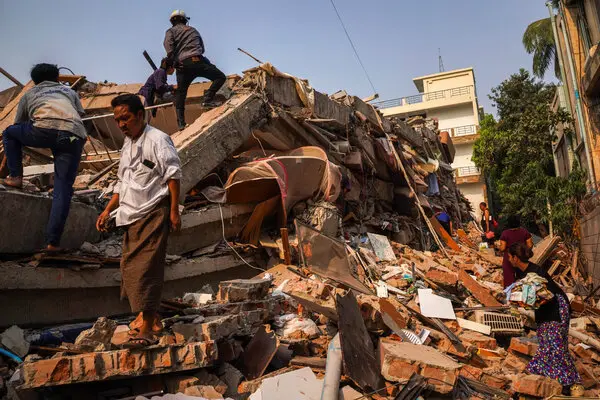Myanmar-Thailand Earthquake : On March 28, 2025, a powerful 7.7-magnitude earthquake struck near Mandalay, Myanmar’s second-largest city, causing widespread devastation across Myanmar and parts of Thailand.
Loss of Life
The quake resulted in significant loss of life, injuries, and extensive damage to infrastructure, prompting a global humanitarian response.

Casualties and Damage
In Myanmar, the earthquake led to approximately 1,700 deaths, with over 3,400 individuals injured and around 300 reported missing.
Mandalay City Earthquake
The destruction was severe in Mandalay, where numerous buildings, including homes, monasteries, and schools, were damaged or collapsed. Critical infrastructure such as bridges, highways, and airports also sustained significant damage, hindering rescue and relief efforts.
Thailand Damage
In Thailand, the tremors were felt as far as Bangkok, approximately 600 miles from the epicenter. The collapse of a 33-story skyscraper under construction in the capital resulted in at least 18 fatalities, with many more feared trapped under the rubble.
Rescue operations are ongoing, but efforts are hampered by blocked roads and unstable structures.
International Aid and Rescue Efforts

The international community has mobilized to assist the affected regions. Countries including China, Russia, India, Malaysia, South Korea, New Zealand, and the United States have dispatched rescue teams and provided financial aid.
Organizations
Organizations such as the United Nations, the Red Cross, and Catholic Relief Services are also contributing supplies and personnel to support search, rescue, and medical operations.
Despite these efforts, local hospitals are overwhelmed, grappling with shortages of food, clean water, and essential medical supplies. The ongoing civil conflict in Myanmar further complicates the delivery and coordination of aid, with damaged communication and transportation networks posing additional challenges.
Regional Impact and Aftershocks
The earthquake’s impact extended beyond Myanmar and Thailand, with tremors felt in neighboring countries such as China, Vietnam, and Laos. In China’s Yunnan province, border cities like Ruili experienced structural damage, including collapsed shopping mall garages and damaged homes.
Vietnam’s capital, Hanoi, and Ho Chi Minh City reported tremors, leading to the evacuation of several buildings. Similarly, Vientiane, the capital of Laos, experienced shaking that prompted evacuations.
The region has also experienced numerous aftershocks, with the strongest measuring 6.7 in magnitude occurring shortly after the initial quake. These aftershocks have caused further damage and heightened fears among residents, many of whom are sleeping outdoors due to concerns about the structural integrity of buildings.
Ongoing Challenges
The disaster has exacerbated existing crises in Myanmar, a nation already grappling with political instability and economic challenges. The military junta’s historical reluctance to accept international aid has complicated relief efforts, although some international teams have been authorized to operate. The opposition National Unity Government has announced a temporary halt to military offensives in affected areas to facilitate aid delivery.
As rescue and recovery operations continue, the full extent of the damage is still being assessed. The international community remains committed to supporting Myanmar and Thailand during this challenging time, emphasizing the need for coordinated efforts to address the immediate humanitarian needs and to plan for long-term recovery and rebuilding.